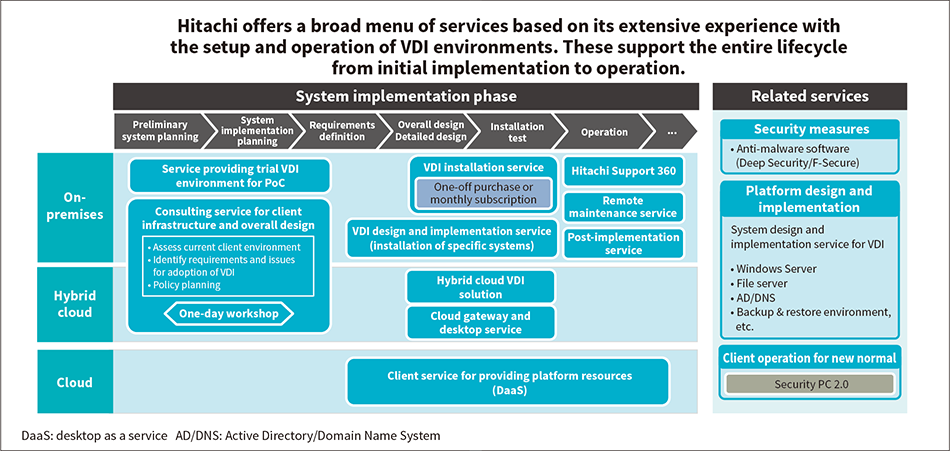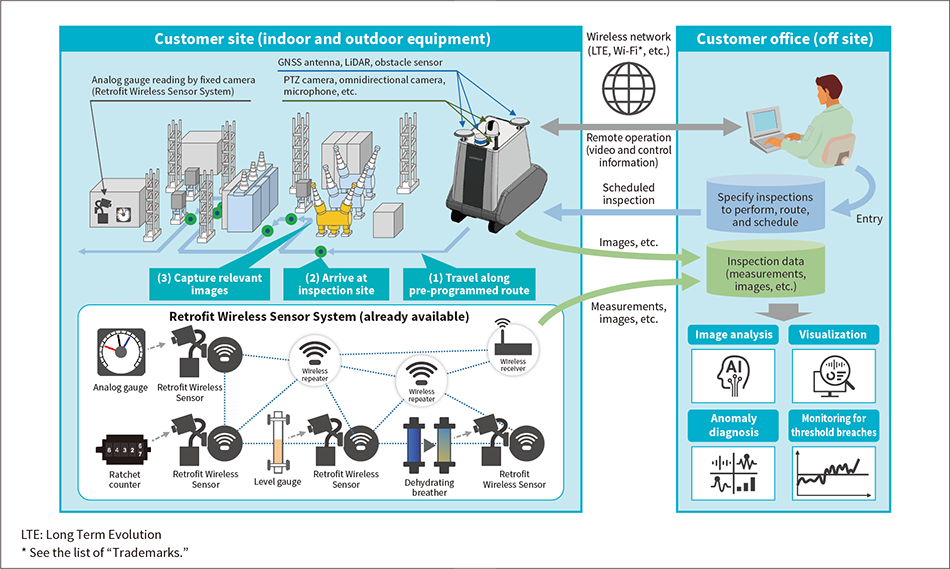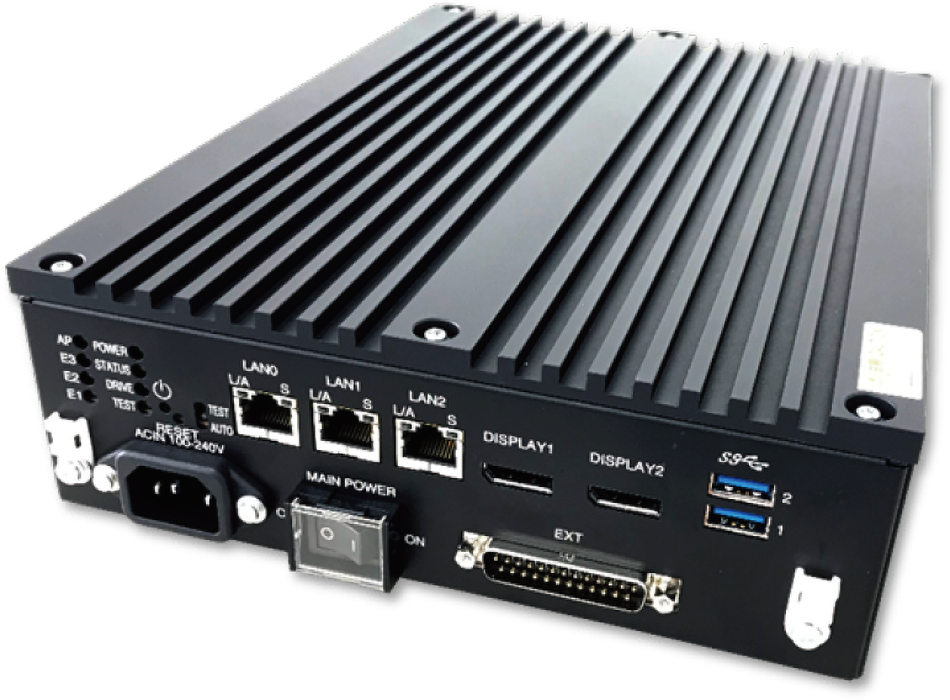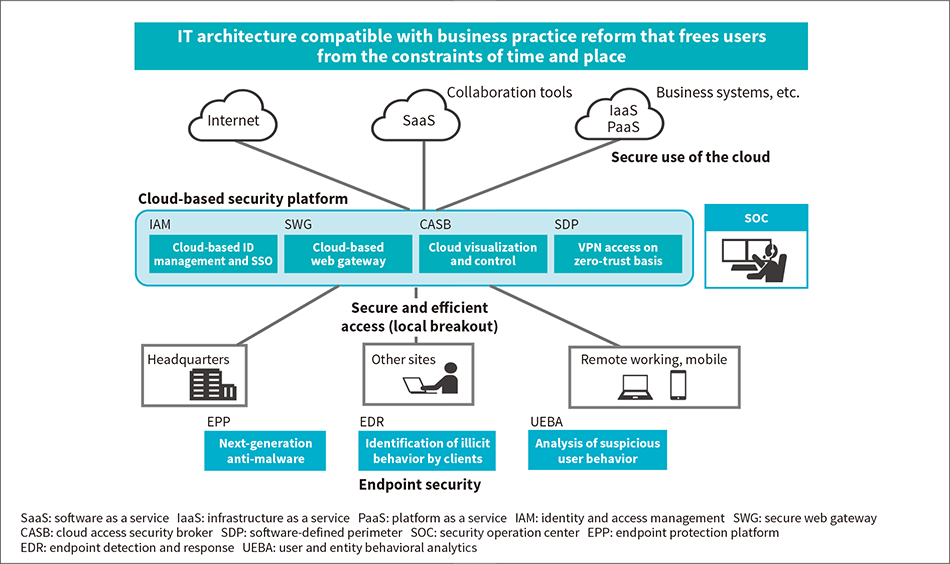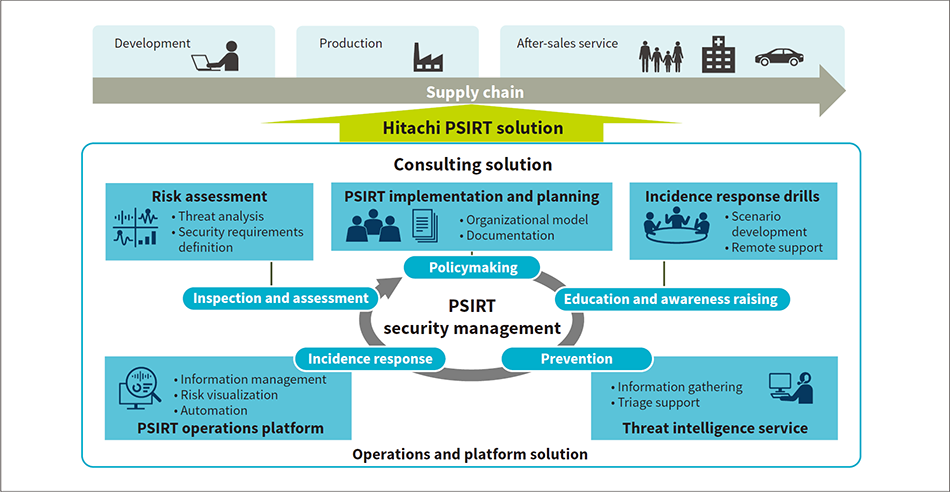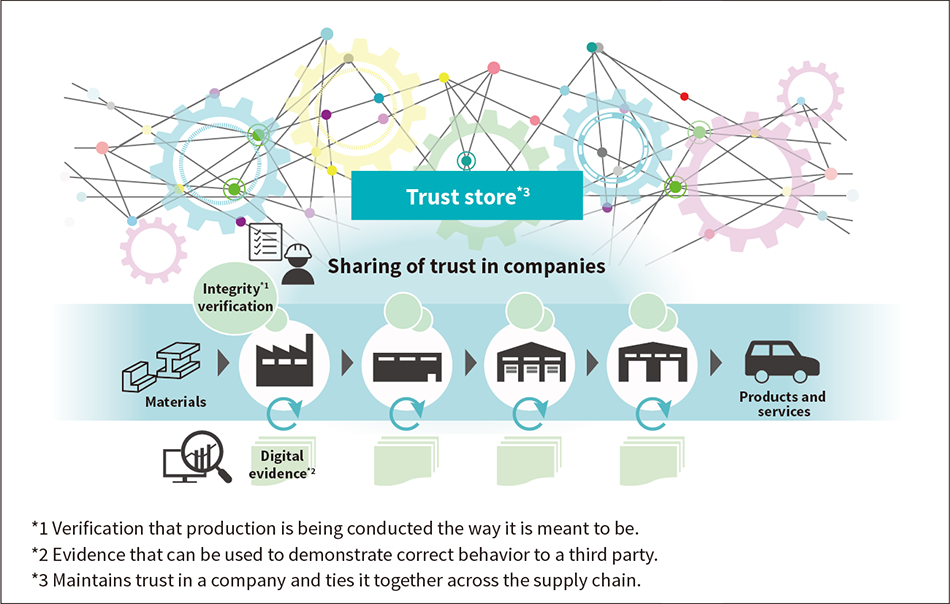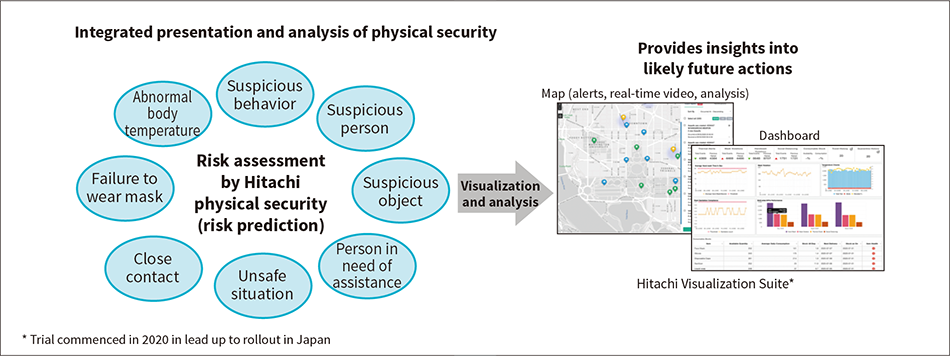Services & PlatformsIT
1. Integrated Operations Management JP1 Version 12 Supports IT Operations in the New Normal
Many companies are shifting their IT systems to the cloud in anticipation of the new normal. As a result, IT departments face the urgent task of utilizing the cloud to further improve IT operations that are becoming increasingly diverse and complex, while also maintaining stable operations across all of their systems, not just those in the cloud.
To support IT operations under the new normal, Integrated Operations Management JP1 Version 12 allows companies to implement remote, centralized management of configuration information and operating statuses linked with applications running in multi-cloud and hybrid environments (environments that include both on-premises and cloud components). By automatically detecting task execution stoppages that lead to critical failures and visualizing the relationships between job execution and the operating statuses of infrastructure components so that problems are easy to isolate, JP1 also makes it possible for companies to take preemptive action in a timely manner to avoid business interruptions, for example, by modifying the runtime environment or switching the job to be executed.
To support IT operations under the new normal, JP1 aims to achieve intelligent IT operations that support the stable operation of entire IT systems as they become increasingly diverse and complex.
[1] Integrated Operations Management JP1 Version 12 helps prevent business interruptions by detecting potential problems before they occur
2. uCosminexus Application Server Version 11 for Easing Migration to Public Clouds
Changes to working practices as a result of the COVID-19 pandemic are speeding up digital transformation (DX), creating a need to optimize system operations and IT investment costs in ways that allow for remote working.
Released at the end of March 2020, Version 11 is the latest version of uCosminexus Application Server (uCAS). Along with easing the task of migrating from an on-premises environment to a public cloud, uCAS V11 also utilizes Amazon EC2* Auto Scaling, a cloud service from Amazon Web Services (AWS), to ensure the reliable operation of mission-critical systems and flexible server operation that can keep up with fluctuations in service load. As well as preventing system outages caused by unexpected loads and the associated business opportunity costs, this avoids overinvestment, reduces the operational workloads of maintenance personnel, and automates the handling of load fluctuations.
In the future, Hitachi intends to continue enhancing uCAS cloud services to provide IT systems that are able to respond to change.
[2] Migration to public cloud achieved by uCosminexus Application Server Version 11
3. New Public Cloud Service: Enterprise Cloud Service G2 (ENC G2)
Interest in public clouds remains high, both as a means of DX and in response to changes in economic activity brought about by the spread of COVID-19. Among the things customers are looking for in a public cloud are rapid system configuration, lower system deployment and operating costs, and support for the rollout of new systems. Along with an existing public cloud system that features high availability and reliability, Hitachi is also responding to customer requirements by adding value in the following ways.
- Use of virtual networking to improve flexibility in network configuration
- Consolidation of conventional network services into a single package to enable load balancing, firewall, and Secure Sockets Layer - Virtual Private Network (SSL-VPN) in one service
- A simple billing plan that charges by the day rather than being based on traffic
- Critical resources (CPUs, memory, and disk) at only half the price of the previous service, with a doubling of CPU performance
- Extensive support services, including a help desk, fault-finding and reporting, and support for system configuration
In the future, Hitachi intends to contribute to the expansion of its customers’ businesses by further enhancing the functionality of its cloud (expanding local data centers, disaster recovery, etc.).
4. Support Service for Microsoft 365 Users and Secret Sharing Security Service for PC Data to Adopt Remote Work
Featuring applications such as Microsoft* Teams* that facilitate close communication between company employees working at different locations, Microsoft 365* is a useful tool for adopting remote working as a countermeasure to COVID-19. Unfortunately, problems can arise with low uptake of Microsoft 365 once it has been made available within an organization. Moreover, taking PCs off-site carries an inherent risk of information leaks because of the potential for loss or theft.
The support service for Microsoft Office 365* users provides comprehensive assistance for the sort of activities that are undertaken to get use of Microsoft 365 established within an organization, including the consideration of how it might be used given the nature of the organization’s business, testing hypotheses, the formulation of a deployment plan, and the running of training sessions that are tailored to users’ actual level of IT skills.
The secret sharing security service for PC data protects user data and the cache data that arises from using Microsoft 365 to maintain a high level of security against data leaks from off-site PCs. This utilizes Hitachi’s proprietary security design know-how and uses a security technique called “secret sharing” that encrypts and splits the data on a PC and distributes it across the PC, smartphone, or other device.
In this way, the service enhances communication between employees who use Microsoft 365 in their work, helping to establish a safe and secure infrastructure for remote working and other similar practices.
5. Utilizing 5G Mobile Telecommunications to Overcome Societal Challenges
Encompassing things like non-contact techniques, automation, and labor saving, DX is becoming more important than ever in the new normal. Hitachi has been taking action to overcome the societal challenges of this new era, including by utilizing the advantages of fifth-generation (5G) mobile telecommunications in its Lumada solutions for various different industries. With its ability to offer high data speeds and capacity, low latency, and multiple simultaneous connections, 5G is speeding up the cyber-physical system (CPS) cycle whereby data collected from the physical world is analyzed or otherwise processed in cyber space and the results used as feedback to the physical world.
Hitachi has developed technology for maintaining reliable communications in real-world environments such as factories or offices, for the dynamic and optimal deployment of software based on the limited capacity of IT resources in the field, and for the implementation of real-time artificial intelligence (AI) on edge devices. By offering such technologies in the form of an edge data center platform for 5G, Hitachi is helping customers make use of CPSs for DX, making it easier for them to deploy and operate solutions that utilize 5G.
6. AI Deployment and Operation Support Service Utilizing XAI
Utilizing explainable artificial intelligence (XAI), a technique for quantitatively and easily providing explanations for predictions or decisions made by AI, this service supports the deployment of AI in business systems and its ongoing operation and improvement.
When utilizing AI in business systems, XAI is available for identifying the deviations of judgements between AI and human experts, also assisting with improvements so that the AI models will be accepted in the workplace. At the subsequent operation stage, XAI makes it possible to continuously improve the AI model by monitoring its behavior, which leads to promote the application of AI to mission critical systems in various real fields. Moreover, the service also helps to establish AI as a routine practice by offering consulting on how to set up and revise systems and practices for continuous improvement.
Under the partnership between Hitachi, Ltd. and Hitachi Consulting Co., Ltd., the service has been launched in order to support customers to realize DX in their businesses, such as creating innovative services and resolutions of their management challenges.
7. Hitachi Virtual Storage Platform E990 Supporting Agile Business Transformation
Under the new normal, the acceleration of DX continues to realize customers’ relentless business growth through their business transformation in rapidly changing external conditions. Prompt response to change is a growing challenge, which extends from large to small companies.
In May 2020, Hitachi released the Hitachi Virtual Storage Platform E990 (VSP E990). The VSP E990 is a storage platform for mid-sized systems, inheriting advanced technologies from the company’s high-end model for large-sized systems to deliver both high performance and better efficiency in data infrastructure.
The VSP E990 adopts the latest Non-Volatile Memory Express (NVMe*) standard and the data access architecture is optimized to process data at high speed with low latency. It also maximizes the value of data by enabling real-time analysis and accelerates the speed of mission critical applications. The VSP E990 also improves data efficiency (operation and possession) by delivering stable performance while consolidating complex workloads required for DX, and optimally combining data reduction technologies such as compression and deduplication. These features enhance the flexibility of response to cope with a rapidly changing business environment.
8. VDI Solution Supporting Safe, Secure, and Flexible Working Practices under the New Normal
Among the requirements for working practices under the new normal is the provision of a safe, secure, and flexible environment for remote work, the use of which has become more commonplace.
Hitachi adopted virtual desktop infrastructure (VDI)*1 as far back as 2004. It now has approximately 130,000 users Group-wide*2, with VDI enhancing business continuity while providing more flexible ways of working and higher productivity. Hitachi has leveraged this in-house experience to supply VDI solutions to a large number of customers, gaining the top share of the Japanese market for (on-premises) client virtualization solutions in 2019*3.
A strength of Hitachi’s VDI solutions is that they offer a wide variety of options covering the entire system lifecycle. Along with operation and maintenance, these include workshops and a service for running proof-of-concept (PoC) trials at the system planning stage as well as services for different system sizes and price points (both on-premises and cloud).
Hitachi intends to continue developing its VDI solutions as a means of providing workspaces that maximize productivity and enable flexible working practices that are people-centric.
- *1
- Desktop virtualization
- *2
- As of March 2020
- *3
- Source: IDC Japan, June 2020, “Client Virtualization Market Share in Japan 2019: Integration into Zero-trust Model” (JPJ45142620) in Japanese.
9. On-site Equipment Inspection Robots That Augment Maintenance Platforms
Among the growing challenges facing the maintenance and operation of public and industrial infrastructure are a shortage of maintenance personnel, a higher risk of outages as equipment ages, and rising maintenance costs. Meanwhile, the new normal brought about by COVID-19 has limited the ability of personnel to get on site. Given this background, there is a strong need to overcome these challenges through such practices as the remote collection of data from sites without human involvement, the digitalization of infrastructure to enable the urgency of preventive maintenance to be assessed, and a reduction in equipment inspection workloads.
Hitachi already supplies solutions that primarily use Retrofit Wireless Sensors capable of reading analog gauges and detecting abnormalities in the sound of operating equipment. On top of this, Hitachi is now developing a new maintenance platform based around surveillance robots equipped with multiple sensors and a high level of autonomous mobility. By effectively combining conventional sensors attached to important equipment in need of continuous monitoring with robots capable of surveying entire plants to search out abnormalities such as those associated with aging equipment, it becomes possible to supply equipment maintenance and inspection solutions at low cost and with a higher level of flexibility than would be possible using either of these approaches on their own. The main features of the surveillance robots and maintenance platform are as follows.
- Autonomous travel control that enables inspections to be performed reliably from right in front of the equipment concerned. As well as being able to navigate its way along a planned route with high accuracy using positioning by a multi-frequency global navigation satellite system (GNSS) and self-positioning by light detection and ranging (LiDAR), the robot’s travel control has the robustness to avoid obstacles either on its own or with the aid of re-routing by a remote operator.
- Equipped with remote control mode to conduct inspections of non-pre-programmed locations, such as during a disaster.
- The robot can be fitted with sensors to suit the intended inspections, such as an omnidirectional camera, pan-tilt-zoom (PTZ) camera, or wideband microphone.
- Image analysis is used to identify and read analog gauges and to detect equipment anomalies such as oil leaks.
- A suite of applications is available, including data visualization and robot control overlaid on a geographic information system.
10. Repair Recommendations for More Efficient Equipment Maintenance in Social Infrastructure
Because the consequences of failure are significant, a high level of availability is demanded from the equipment that serves as a point of contact between the public and social infrastructure, such as ticket vending machines at railway stations or bank automated teller machines (ATMs). Moreover, as equipment failures can lead to close contact as people queue for over-the-counter services, the current COVID-19 pandemic calls for repairs to be made more quickly than ever. One of the obstacles to shortening repair times is the issue of how to improve the efficiency of on-site work and inquiry handling that relies on the skills of maintenance staff.
Hitachi’s repair recommendation service uses AI to overcome this problem. The service works by building a customer-specific AI engine that is trained on repair records and other historical data. The AI engine is then used to help maintenance personnel decide what to do when a fault occurs by automatically generating suggestions as to which part of the machine is most likely to need repair and the best parts to use for this purpose. A feature of the service is that building the AI engine can be completed quickly and efficiently by using proprietary Hitachi tools such as dictionary-less analysis.
To assess how well the service does at shortening repair times, its performance at selecting which parts to replace was assessed in secondary inquiries of ATM faults. The results indicated that parts selection took approximately 38% less time when using the service. The assessment also demonstrated that the service made the task of parts selection less skills dependent. It performed at the level of an experienced worker and recommended the correct parts even when faced with the sort of complex problems that a maintenance person with an average level of skill would find difficult.
[10] Application of repair recommendation to ATM maintenance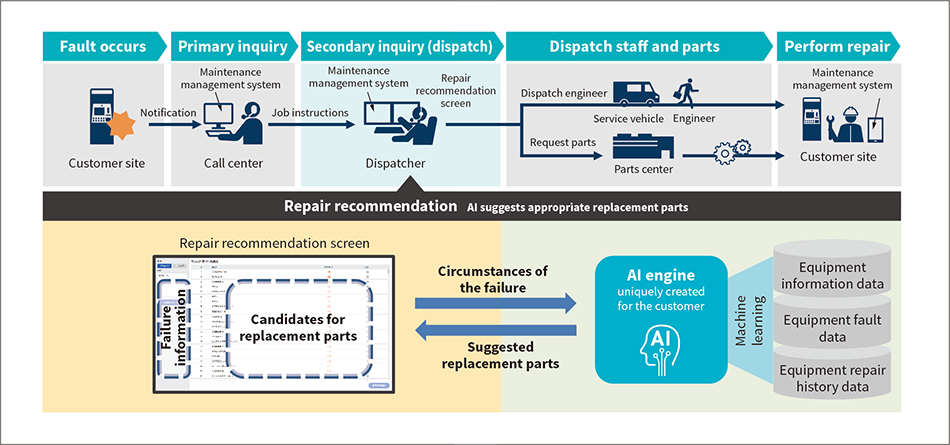
11. Industrial Edge Computer CE Series That Achieves Image Recognition Using Embedded AI
As one of the means of achieving labor saving and automation in IoT edge solutions, the use of image recognition based on deep learning is growing in applications such as quality inspection and security where it is recognized for its potential to overcome a variety of challenges. To allow for the collection of data from equipment installed under harsh conditions, edge computers also require ruggedness and the ability to run for long periods of time.
To address these issues, Hitachi’s industrial edge computers incorporate the following solutions.
- OpenVINO* toolkit is pre-installed
The implementation of image recognition solutions is simplified by using learning models generated by a generic framework. - Fan-less with no vents or spindles
This helps ruggedize the devices for use at industrial sites and reduces their maintenance requirements. Installation at sites where space is at a premium is also facilitated by keeping the computers to a footprint of roughly the size of A4 paper. - Long-term availability of both product and support
The computers are manufactured by Hitachi in Japan to ensure a dependable supply of reliable products, with long-term support available (up to 10 years).
12. Programmable Controller Combining High Performance and Reliability
Market globalization and growing diversity in customer preferences is driving strong demand for programmable logic controllers (PLCs) that offer additional functionality at a lower price. When upgrading existing systems, however, a high priority is placed on being able to reuse software and hardware assets, making backward compatibility an essential requirement for new products. Hitachi developed the high-performance S10VE programmable controller to meet this demand and it is now on sale.
Along with incorporating the advanced functions of its predecessor, the S10V, the new S10VE also delivers higher performance and features a newly developed special-purpose integrated circuit (IC) capable of executing ladder logic with cycle times as short as 9.4 ns. It also features improved usability to cope with the growing size of ladder logic programs and a main memory error correction function for enhanced reliability.
To ensure backward compatibility, the S10VE provides continued support for three different programming languages: ladder logic, the HI-FLOW flowchart language, and C. The new S10VE also allows for the reuse of users’ existing software, with ladder logic programs developed for earlier models such as the S10mini and S10V able to be converted to run on the S10VE by means of a conversion program that is included as a standard feature.
13. Information & Control Platform and Fault-Tolerant Computer
Hitachi’s information and control platforms are used in applications such as transportation and electric power generation and distribution that demand high reliability and real-time control.
This includes fault-tolerant equipment models for systems that place a high priority on availability and on data being reliable and consistent. Hitachi has recently released a new fault-tolerant computer that also meets the demand for high performance and advanced functionality.
The new computer is made up of a number of blocks connected together by a high-speed network. These include CPU blocks with a loosely coupled quad configuration, voter modules that select data from the CPU blocks on a majority-vote basis, and reliability/availability/serviceability (RAS) blocks that monitor what is happening in the computer. This configuration delivers highly reliable data processing with a high level of performance.
As a device designed to play a core role in critical systems, Hitachi intends to expand applications for the computer into new services that demand high availability and data reliability, such as those for reducing or eliminating human labor.
[13] Exterior view and block diagram of fault-tolerant computer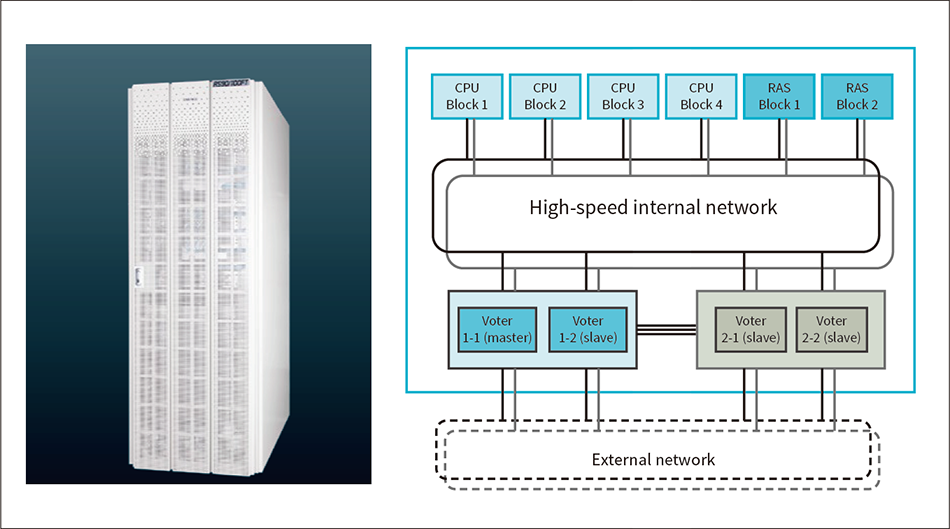
14. Zero-trust Security Solution Required by a Cloud and Remote Work Society
Zero-trust security has attracted attention amid moves to accommodate work style reforms and other modern working practices. Together with the rise of remote work and use of the cloud, the growing sophistication of cyberattacks means that it is no longer possible to rely upon the traditional “border defense” approach to security whereby in-house activity was assumed to be safe. Instead, an entirely new architecture needs to be adopted that is predicated from the outset on use of the cloud and the Internet.
A variety of background factors and requirements influence what customers want from zero-trust security, including VPN-blocking, work style reform, and cyber-resilience improvement. Based on its own in-house experience and expertise in adopting zero-trust, Hitachi’s solution designs a system-wide architecture and migration roadmap for zero-trust security that is optimized to suit the customer’s business circumstances and IT infrastructure. The service helps to deliver the form of zero-trust security that customers are calling for by choosing a mix of products that is optimal in terms of the customer’s requirements from among the wide range of solutions and services offered by Hitachi companies, which include endpoints, stronger authentication, and cloud security.
15. Hitachi PSIRT Solution for Strengthening Companiesʼ Product Security
Recent years have seen a rise in cyberattacks on Internet-connected devices (IoT devices). This has placed high expectations on the companies that develop and manufacture these devices to establish product security incident response teams (PSIRTs) to ensure the prompt identification of causes and countermeasures and the publication of information relating to vulnerabilities or security incidents with their products across the entire product life cycle (supply chain). Unfortunately, the shortage of people with specialist security expertise makes it difficult for companies to establish such arrangements on their own.
The Hitachi PSIRT solution takes maximum advantage of the experience and know-how available within Hitachi to provide its corporate customers with total support for security management, covering both consulting and platforms.
The consulting solution enhances governance by serving as a one-stop source of support for PSIRT operations. The operations and platform solution reduces operational workloads, speeds up incident response, and reduces reliance on skilled individuals by providing infrastructure for the analysis and centralized management of information on threats and vulnerabilities.
- *
- Product URL: https://www.hitachi.co.jp/products/it/security/solution/productsecurity/index.html in Japanese.
16. Hitachi Technologies for Building Trust Supply Chains
Incidents of illicit activity in supply chains has become a serious public issue over recent years against a background of more intense price competition and worsening shortages of technical personnel. Meanwhile, supply chains are becoming more complex and global at an accelerating rate, with the advance of digitalization enabling the sharing of information on what is happening as data moves backwards and forwards between producers and consumers in real time. As a result, trust in supply chains is becoming ever more important as more questions are being asked about the form that products and services are taking.
Hitachi is seeking to combine its products and practical expertise (especially those associated with social infrastructure) with the latest digital technologies to build trust supply chains, supplying technologies that leverage its domain knowledge from sources such as factories, distribution, and retailing. The objective is to establish such trust supply chains by providing the transparency to see whether production activity along the chain is happening as it should, thereby fostering trust, and by linking together the means of achieving this.
17. Digital Transformation of Physical Security to Support Risk Management under the New Normal
2020 has seen a wide variety of measures adopted in response to the threat of COVID-19. Along with avoiding the “three Cs” of closed spaces, crowded places, and close contact-settings, these also include hand washing, disinfection, mask wearing, and body temperature measurement. Hitachi’s physical security solutions that incorporate video analysis, three-dimensional (3D) lidar, and other such technologies can be utilized to make the management of these practices more efficient and automatic.
While making these a regular part of people’s working and living routines is one of the objectives of the new normal, there is also a need to keep up with countermeasures to other potential new threats. Unfortunately, the adoption of such diverse countermeasures is accompanied by management and operational overheads and an inability to identify and analyze the outcomes of enacting these countermeasure risks creating a situation where it is not possible to make decisions about things like cost-benefit or changing circumstance in a timely manner.
Hitachi Visualization Suite (HVS) provides the key to visualization and analysis. Through the DX of physical security, it enables the integrated presentation and analysis on a map or dashboard of not only measures for dealing with COVID-19, but also for various other physical risks that impact safety and security. This can then be used to support the activities of managers and administrators by providing insights as to what is happening.






